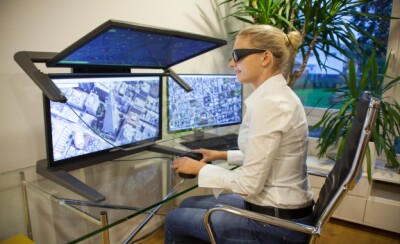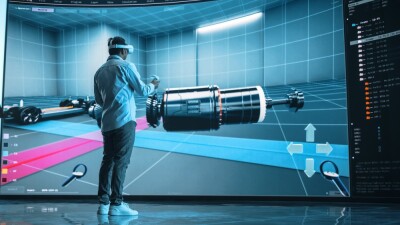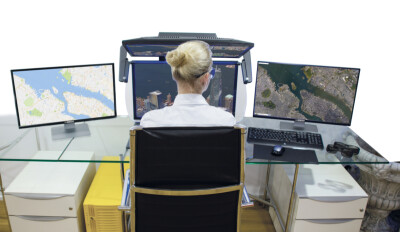Even if it hasn’t always been articulated, it’s always been inherently known that visualizing things in three dimensions is far more beneficial for humans than doing so in two dimensions. It is, after all, the way we interpret the world on a day-to-day basis. The issue for visualizing intangible objects like designs in 3D has always been a lack of technological ability to do so, meaning we ultimately got used to 2D planning. Although we still haven’t perfected our abilities to view things in three dimensions, the technology is certainly improving with different options. There are plenty of 3D applications for desktops and other devices, though that still isn’t exactly a 3D view. There is also the ever-growing space around wearable headsets, but that comes with its own problems.
One other option on the market that allows for 3D visualization in a more comfortable setting is what’s known as a 3D stereo monitor, like Schneider Digital’s 3D PluraView and VR PluraView. This technology and its benefits was the subject of a recent webinar, entitled Improved Understanding and Visualization of Complex Data Using 3D Monitors, hosted by Geo Week News and sponsored by Schneider Digital along with Kelyn 3D, an authorized distributor of Schneider’s products in the US and Canada, and the only authorized repair center in North America for PluraView 3D, who spoke with Geo Week News at this year's Geo Week event in Denver. The webinar featured the following speakers:
Josef Schneider, Managing Director, Schneider Digital
Kurt Vanderheiden, Business Development, Kelyn 3D
The hour-long webinar began with Schneider providing some background about the company’s 3D monitors, their history, and what kind of work can be completed. He ran through the nearly 20 years of history in creating and distributing these “passive display” monitors, going back to 2005 with their first model. He also noted the shorter, but still lengthy, experience they have with projection 3D stereo systems, with this going back to 2010 with the introduction of their first generation smartVR Wall.
Along with that history, Schneider also shared the wide array of sectors that can take advantage – and are taking advantage – of this kind of technology, including but not limited to oil & gas reservoir modeling, simulation and VR training, BIM and lidar visualization, 3D city model visualization, and GIS/mapping. For all of these use cases, it makes sense that Schneider also boasts a massive number of compatible software applications – over 400, according to both Schneider and Venderheiden.
That’s just a piece of the comprehensive overview provided by Schneider to start off this webinar, as he also delved into VR capabilities, their different mouse and controller options, their new 80-inch monitor for enterprise applications, and more.

Following that overview from Schneider, both speakers came together to answer some prepared questions from Geo Week News as well as questions from viewers. As part of that section, they compared these 3D monitors to mixed reality headsets such as the Apple Vision Pro. Schneider noted that headsets will “drive the application market,” but that user acceptance is inconsistent and often goes in a downward trajectory. For 3D monitors, however, that acceptance is generally steady.
This is for fairly intuitive reasons, too, largely coming down to comfort. With a monitor, you obviously don’t have to wear anything on your head, something that Vanderheiden points out can lead to some negative effects after prolonged usage. With the 3D monitor, it’s simply like sitting at any computer monitor – he referred to it as the “most comfortable and accurate way to visualize 3D” – with the added benefit of multiple people being able to view the same screen. The applications shouldn’t be any different, either. Schneider told the audience that if a professional application is able to work on an Apple Vision Pro, for instance, it can work on the monitors.
They also delved a bit into the ways that this technology is being used in the real world, and way. Vanderheiden says broadly that his customers in the North American market most often relay positive feedback around comfort, a theme that continued to pop up throughout the webinar. Looking more specifically, he discussed how one of his clients, Foresite, is using it. A Canadian firm who specializes in forestry, he relayed that PluraView is “used by their interpreter team to develop and validate field sampling programs, lidar prediction models, satellite prediction models, and their final deliverables,” while also using the tool for quality assurance through their workflow.
Finally, Schneider talked about some of the future plans as the company continues to try and innovate, meeting the latest trends in the enterprise space. This includes ways to make remote work over a single server an easier process, something that Vanderheiden says has been a common request among their customers. Today, Schneider says, users can do this with Teredici hardware acting as an in-between, but they are working on a software solution to be more flexible.
As companies look for better ways to visualize their projects in three dimensions, this kind of stereo monitor could make more sense than headsets for many use cases. Most questions that could come up about delving into this space were answered in this webinar, which you can still view on-demand by filling out the free registration form found here.






